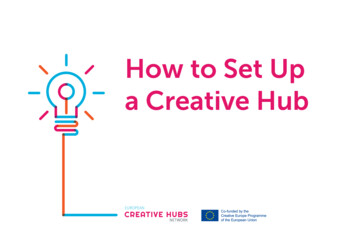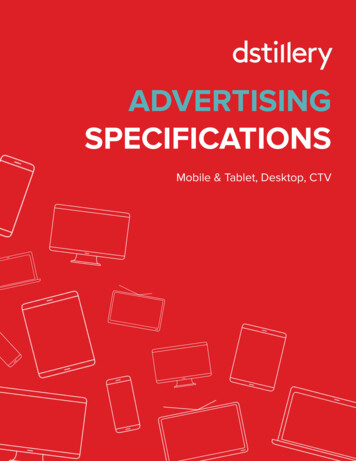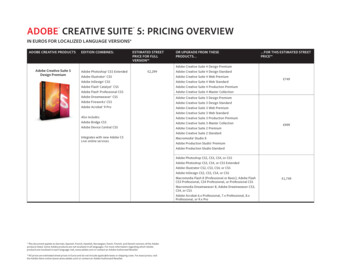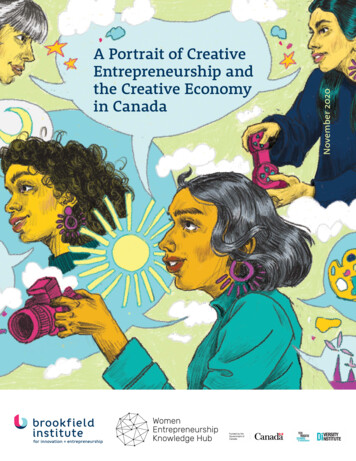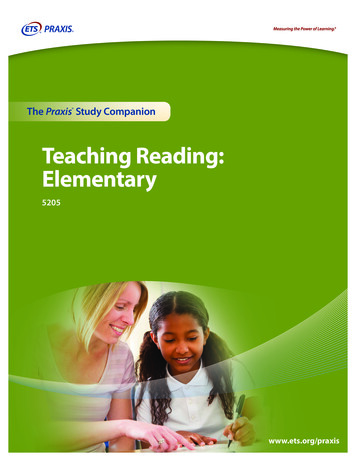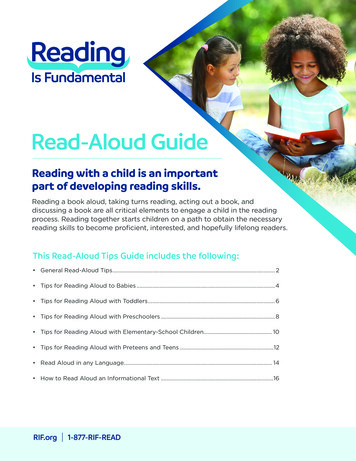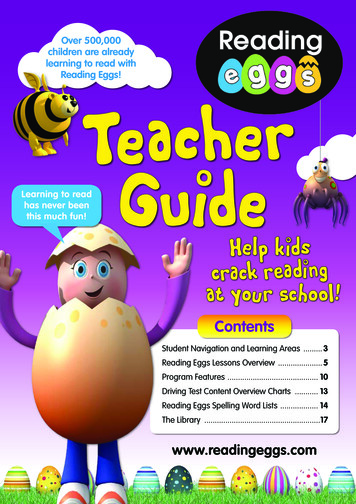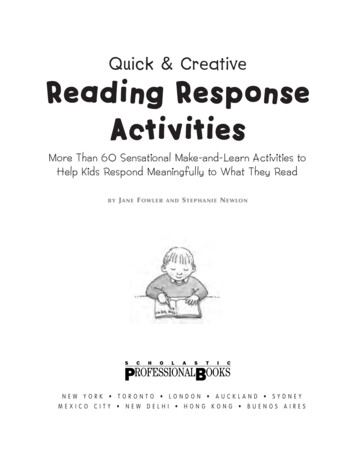
Transcription
Quick & CreativeReading ResponseActivitiesMore Than 60 Sensational Make-and-Learn Activities toHelp Kids Respond Meaningfully to What They ReadBYJ ANE F OWLERANDS TEPHANIE N EWLONNEW YORK TORONTO LONDON AUCKLAND SYDNEYMEXICO CITY NEW DELHI HONG KONG BUENOS AIRES
This book is dedicated to our families, who have found ways to beunderstanding and tolerant of the many hours we have spent creating,preparing, and sharing our ideas with fellow educators near and far.Thank you, we love you.AcknowledgmentsWe would like to take this opportunity to acknowledge the students in our classrooms.Over the years, they have taken our ideas and expanded and altered them to create newlearning possibilities. What an exciting and rewarding experience this has been.Yes, learning and teaching can be fun!Scholastic Inc. grants teachers permission to photocopy the reproducible pages from this book for classroom use.No other part of this publication may be reproduced in whole or in part, or stored in a retrieval system, or transmitted inany form or by any means, electronic, mechanical, photocopying, recording, or otherwise, without written permission of thepublisher. For information regarding permission, write to Scholastic Inc., 557 Broadway, New York, NY 10012.Interior design by Holly GrundonCover design by Jim SarfatiInterior art by James HaleISBN: 0-439-09845-9Copyright 2003 by Jane Fowler and Stephanie NewlonAll rights reserved.Printed in the U.S.A.Published by Scholastic Inc.1 2 3 4 5 6 7 8 9 10 40 09 08 07 06 05 04 03 03
A BC DE F GH I J K LM N O P QR ST U VW XY ZContentsIntroduction . . . . . . . . . . . . . . . . . . . . . 4Accordion Books . . . . . . . . . . . . . 6A-mazing Adventures . . . . . . . . . 6Notable Necklaces . . . . . . . . . . . 19On Board . . . . . . . . . . . . . . . . . . 19Brown Bag Backdrops . . . . . . . . . 7Book Bag Puppets . . . . . . . . . . . . 7Character Cash . . . . . . . . . . . . . . 8Character Cards . . . . . . . . . . . . . 8Design and Decorate . . . . . . . . . . 9Diary . . . . . . . . . . . . . . . . . . . . . 9Problem-Solving Predictions . . . 20Puzzle Cards . . . . . . . . . . . . . . . 20Personal Picture Frames . . . . . . . 21Playtime . . . . . . . . . . . . . . . . . . 21Quilt Talk . . . . . . . . . . . . . . . . . 22Rock’n’Roll . . . . . . . . . . . . . . . . 22Event Cards . . . . . . . . . . . . . . . . 10E-mails . . . . . . . . . . . . . . . . . . . 10Filmstrips . . . . . . . . . . . . . . . . . . 11Fun Facts . . . . . . . . . . . . . . . . . . 11Fun Fax . . . . . . . . . . . . . . . . . . . 12French Fry Facts . . . . . . . . . . . . . 12Stationery . . . . . . . . . . . . . . . . . 23Superhero Capes . . . . . . . . . . . . 23T-Shirts . . . . . . . . . . . . . . . . . . . 24Tea Bags . . . . . . . . . . . . . . . . . . 24Umbrellas . . . . . . . . . . . . . . . . . 25Great Graphs . . . . . . . . . . . . . . . 13Gloves . . . . . . . . . . . . . . . . . . . . 13High-Five Hands . . . . . . . . . . . . . 14Hugs for the Characters . . . . . . . 14If I Were. . . . . . . . . . . . . . . . . . 15It Made Sense . . . . . . . . . . . . . . 15V Is for Vacation . . . . . . . . . . . . 26Vests . . . . . . . . . . . . . . . . . . . . 26Wonder Wands . . . . . . . . . . . . . 27Watch the Character Change . . . 27X-rays . . . . . . . . . . . . . . . . . . . 28X-tra, X-tra, Read All About It! . 28Jumbo Trading Cards . . . . . . . . . 16Kites . . . . . . . . . . . . . . . . . . . . . 16You Be the Character . . . . . . . . . 29Yesterday . . . . . . . . . . . . . . . . . 29Lightbulb Lab . . . . . . . . . . . . . . 17Literacy Times . . . . . . . . . . . . . . 17Zip! . . . . . . . . . . . . . . . . . . . . . 30Mailboxes . . . . . . . . . . . . . . . . . 18Mood-o-Meter . . . . . . . . . . . . . . 18Student Pages. . . . . . . . . . . 313
A BC DE F GH I J K LM N O P QR ST U VW XY ZIntroductionWelcome to Quick & CreativeReading Response Activities!Reading is a solitary activity. At the same time, we know thatencouraging kids to talk about books—to share their thoughts andinterpretations with others in interactive and creative ways—buildscomprehension. The activities in this book help children do just that!Increasing comprehension adds joy and pleasure tothe reading experience. The reading response activitiesyou’ll find in these pages help children reflect upon anybook they’ve read, forming the foundation for furtherquestioning and discussion.Though the activities may originate as nonverbal, theyoften lead to more discussion. Sharing these activitiesboosts the confidence of reluctant readers and encouragesthem to take part in group discussions. Sharing theseprojects is also valuable both for the listener and the child who isparticipating. The child develops confidence, the audience developslistening skills—and everyone becomes aware of one another’sappreciation and interpretation of literature. Sharing develops a spiritof community!In our classrooms, we’ve found that activities like these build a loveand appreciation of literature—and make teaching and learning moreenjoyable for all. These activities will promote literal comprehensionand build skills in explicit recognition and recall. They’ll help childrenorganize their ideas and information, and help them use this informationas an experience base in judging literature. And besides . they’re lotsof fun!— Jane Fowler & Stephanie Newlon4
A BC DE F GH I J K LM N O P QR ST U VW XY ZUsing This BookFor each letter of the alphabet, you’ll find one or morereading response activities that can be used with any book.You might:let children choose their own projects (introduce several activitiesand encourage children to choose among them), or assign thewhole group the same project.invite children to do the projects as book reports, or as extensionsof traditional book reports.have children work in small groups to complete a project together.have children stand in front of the group to share their work whenfinished, explaining what they’ve done and how it relates to the pieceof literature.list several of the projects (with instructions) on chart paper and displayat a learning center, so that kids can choose and complete them duringcenter time.assign the projects as homework or as family projects.invite children to share an “alphabet” of responses at open house.Display and label a response activity for each letter of the alphabet, andhave children share their work as families visit the classroom.5
A BC DE F GH I J K LM N O P QR ST U VW XY ZAAccordion BooksDivide the class into groupsof three to five students.The group members then dividethe story into the number ofpeople in the group (forinstance, if there are fourpeople in the group, they dividethe story into four parts). Then,each child explains whathappened first, second, thirdand last in the book. Each member of the group is responsible forsummarizing and illustrating their part of the story on a blank piece of whitepaper. When complete, children lay their papers side by side and tape themtogether. They then fan-fold the pages to create an accordion book, andshare their story with the rest of the class.A-mazing AdventuresNameic ProfessionalActivities ScholastBooks1.4.3.Quick & CreativeReading ResponseAwes om eAd ve ntur es326DateA-Mazing A2.Draw attention to theadventure and action in anybook! Provide children with a copyof “A-mazing A” (page 32).Encourage them to list fouradventures or actions from thestory. Have them color their A, andadd symbols that relate to the story.Then, children cut out the lettersand punch a hole in the top. Hangthe A’s from the ceiling—you’ll haveone action-packed room!
A BC DE F GH I J K LM N O P QR ST U VW XY ZBrown Bag BackdropsHelp children use small brownpaper lunch bags as backdropsfor stick puppets. Encouragechildren to decorate their bags withan appropriate scene from a storyand then create and color stickpuppets (representing charactersfrom the story), using index cards,tape, and craft sticks. The puppetscan be stored in the bags. Childrenwill build oral communicationskills by retelling a story usingtheir bags and puppets.BBook Bag PuppetsUse brown paper lunch bagsto create book reports! Usethis activity to retell a story (orgenerate a new story based on theoriginal story’s characters orconcepts). Turn the bag upsidedown. Use the rectangle at top fora character portrait and staple awritten summary onto the body ofthe bag (see right). Children willfind they’ve made a puppetaccompanied by a small book!7
A BC DE F GH I J K LM N O P QR ST U VW XY ZCharacter CashCHNameQuick & CreativeReading ResponseDateCharacter Cashic ProfessionalActivities Scholastave children choose a character from a story they’ve read. Everycharacter becomes a millionaire with this activity! Provide each childwith a copy of page 33 to create currency for their character.(Remind children what is on U.S. currency: symbolsrepresenting important people and places, different numerals,dates, and so on.) Encourage children to draw a picture oftheir character, and to add symbols to the front and back torepresent important qualities of the character. Children mightadd titles by the same author, the character’s city or town,and so on. Numerals might represent the character’s age. Youmight even have children cut out their character cash, thenwork in small groups to create math problems with the bills!Books33Character CardsBring characters to life with crayons and large index cards. First, havechildren create an easel to showcase these character cards. Fold anindex card in half and cut on the open side to form the letter L (see below).Children can decorate their easels with small symbols from the story. Then,have them use another index card to draw a picture of their favoritecharacter from a book and write adescription of the character on theback (these descriptions mayinclude physical characteristics,likes, dislikes, personality traits,goals, problems, family, andfriends). The character cards fiton the easel for easy display.Children can then “introduce”their character in small groupsor to the whole class.8
A BC DE F GH I J K LM N O P QR ST U VW XY ZDesign and DecorateProvide sheets of white butcher paper and encourage children to usecrayons or markers to design and decorate a home or room for acharacter in a story. Mention that they should think about their charactercarefully to know what he or she would want to have in his or her roomor house. Children should be able to explain why they created certain thingsin the room and how they reflect the character, based on information in thestory. This provides a wonderful opportunity to observe children’s insightinto a character! Children can give “tours” of the house or room to the restof the group.DDiaryAclassroom diary is an excellentcomprehension strategy to use following adaily read-aloud. Ask a different child to writean entry in a class notebook every day. Childrenshould summarize the story in a few sentences,and write a comment about the plot or characterdevelopment. If children illustrate the entries,you will have a delightful class book that kids canenjoy over and over again. These entries can beused to revisit the many characters and storiesyou’ve enjoyed each day. This makes an impressivedisplay for classroom visitors and parents.(Children can also keep individual book diaries using smallcomposition books kept in their own desks, then share themwith small groups or the whole class.)9
A BC DE F GH I J K LM N O P QR ST U VW XY ZEEvent CardsSequencing events in a story is a vitalelement in comprehension — andthis activity provides students with theopportunity to do just that. Give studentsthree or four index cards in a variety ofcolors. Children draw on one side of thecard and write the events of a story on theother side, telling what happened first,next, and last. They then exchange cardsets with a partner, who attempts to putthem in the correct order. Children checkeach other’s work (they might hide a smallnumber noting the correct sequence on theback of each card as a self-checking device).E-mailsEveryone gets e-mails; why not the characters of your favorite books? Havechildren make up imaginary e-mail addresses for their characters. Ask,How do people decide on e-mail addresses, anyway? What would be a good e-mailaddress for your character, and why? You might print out a blank e-mailtemplate and copy it for children to write on. They can write a message totheir character, or write it as though they were the character.10
A BC DE F GH I J K LM N O P QR ST U VW XY ZFilmstripsHave children use adding machine tape to re-create the most excitingpart of the story. On the tape, they should draw pictures and writeabout the events of the story in order. (These “filmstrips” can also be used tolist vocabulary or spelling words.) They can be rolled up and kept in emptytoilet paper rolls that have been decorated with symbols from the story. Thecompleted tubes can be collected and kept in shoe boxes (labeled “adventurebooks,” “fantasy books,” “compound words,” “vocabulary words,” “favoritecharacters,” “spelling words we know,” and so on) for independent viewing.FFun FactsChildren can record facts from a nonfiction story on index cards andhang them around the room, providing an instant resource center forreports. In small groups, students can research a selected topic and recordfacts on index cards. They can then draw or paint a large figure and hang thecards together in groups of four or five. For instance, if children read a storyabout a whale, they can make a large whale from posterboard or constructionpaper and attach these fact cards with yarn to the whale’s body. Hang thewhale from the ceiling or bulletin board for easy reference.11
A BC DE F GH I J K LM N O P QR ST U VW XY ZFFun FaxCommunication comes alive in yourclassroom with your own fax machine! Makea pretend fax machine from an empty cereal box.Cover and decorate it to look like a fax machine(cut a slit at each end where papers can passthrough). Discuss the purposes and uses of a faxmachine, then encourage children to “fax” amessage to a character in a story! These messagescan be read aloud and answered as a group orindividually. Collect the faxes and their responsesin a folder entitled “Fabulous Faxes.”French Fry FactsDiscuss the difference between fact and opinion. Provide each child witha white paper lunch bag (cut with pinking shears to resemble a frenchfry bag) and four strips of yellow paper (french fries), two by six inches long.Encourage children to write down four facts from a story (such as setting,characters, problem, and solutions, or what happened first, second, third,and last in the story). Then have them write sentences on the french friesand put them in the white sack!12
A BC DE F GH I J K LM N O P QR ST U VW XY ZGreat GraphsCreate a graph with two columns: questions and answers. Choosequestions that relate to your spelling, grammar, or vocabulary lessonsand have children go back to a chosen story or chapter and find the answers.For instance, How many short a words can you find in the story? How manywords with five letters on page 6? How many new vocabulary words can you find?How many words can you find on page 6 that start with th-? Have childrenrecord the numbers to create a class graph.GGlovesHave each child trace his or her hand onto a plain piece of white paperand cut it out. On the palm, children should record the title andauthor name, then write different events from the story on each finger. Thenhave them glue the hands onto colored construction paper and display themon a bulletin board. (If you do this during cold weather, you might entitlethe display “Warm Up Your Hands With a Good Book!”)13
A BC DE F GH I J K LM N O P QR ST U VW XY ZHigh-Five HandsHHave each child trace his orher hand onto a plainpiece of paper. On the palm,children can write a character’sname. On each finger, they canwrite a reason their characterdeserves a “high five”! Cut outthe hands, mount them onconstruction paper, and displaythem on a bulletin boardlabeled “Give Reading aHigh Five!”Hugs for the CharactersNameHugs for the ChdessaervehugbecausDatearacterEvery character deserves a hug! Copy page 34 for each childand spread the hugs around as children fill in the hearts withreasons their character needs a hug. Children then color and cutthem out to create a bulletin board entitled “Everyone Deservesa Hug.”eAnother hug foric ProfessionalActivities ScholastuseforQuick & Creativebecaig hugReading ResponseOne bBooksbecause3414
A BC DE F GH I J K LM N O P QR ST U VW XY ZIf I Were . . .GDateIf I Were.If I were,I would.Reading Response ActivitiesScholastic ProfessionalBooksI would alsoQuick & Creativeet the creative juices flowing as youask children to step into the characterof a book! Copy page 35 for each child andhelp him or her complete it. Childrendescribe what they would do if they werethe character, and why. When completed,they can share their ideas with the class.These “If I Were.” sentence stems canalso be used as interview questions, aschildren ask each other to share otherevents in the story and what they wouldhave done.IName35It Made SenseHave each child create a sense chart:two columns of five rows, one foreach sense (seeing, tasting, hearing,smelling, touching). Choose a story, andencourage children to fill in the chartnext to the appropriate senses. (Forinstance, in Charlie and the ChocolateFactory, Charlie smells chocolate, tastesthe gobstopper, sees Oompa-Loompas, andso on.) The completed charts may be usedas a brainstorming tool prior to writing aparagraph describing a character or anincident he or she was involved in. Thesecharacter charts may also be comparedwith other projects on characters in theroom. It will “make sense” to use these asas a unique comprehension tool!15
A BC DE F GH I J K LM N O P QR ST U VW XY ZKKitesGive each child a diamond-shapedpiece of construction paper andtell the group they are going to makea kite that tells a story. First, havethem fold the paper in half twice, tocreate four triangles. The kite willbecome a story map for the setting,character, problem, and solution! Useyarn and ribbon to create a tail for thekite—and tie on important vocabularywords (or simply favorite words thatchildren choose). Encourage students toretell the story as they “fly” (show to thegroup) their kite.16NameJumbDateo Trading CardCharacter CardName:Book sLives in:ic ProfessionalActivities ScholastCharacter’s AgeReading ResponseShare a variety of trading cardswith the group. Discuss theinformation found on the cards,then encourage children to createa “Jumbo Trading Card” for theirfavorite character. Provide each childwith a copy of page 36 and help themfill in the blanks and draw and color afavorite character. Then, play a gamein which a child reads the character’sinformation and the class guesses thecharacter. Exchanging and sharing thesecharacter cards in small groups is a greatway to encourage small-group discussion.Quick & CreativeJJumbo Trading Cards
A BC DE F GH I J K LM N O P QR ST U VW XY ZLightbulb LabLCopy page 37 for each child. On the“shining events” lines, childrenwrite three important events from astory. Then they write down threeproblems in the story on one side ofthe bulb and three correspondingsolutions on the other side. They canthen color their bulbs. Watch faceslight up with learning!NameDateL ig ht b ul b LaSo lut ion stEvenin gShin ing EvenSh in inS h ing EvenQuick & CreativeReading Response ActivitiesScholastic Professional BooksttPr ob lem sbTitleAut hor37Literacy TimesWhat better way to review question words(Who, What, Where, When, Why andHow), than with your own Literacy Times? Havechildren form five groups and assign each group asection of the paper (front page, sports, comics,world news, and even classified). Usinginformation from a chosen book, each groupwrites an article for the Literacy Times. Thisactivity may also be done individually, with eachchild creating his or her own front page.17
A BC DE F GH I J K LM N O P QR ST U VW XY ZMailboxesMHave children design mailboxesfor a character, using shoe boxesor empty oatmeal containers. Childrencan cover the boxes and decoratethem with symbols from the story thatreflect the character or storyline.Invite children to write letters orpostcards to the characters (or fromtheir character to the class), anddeliver them to the correct mailboxes.You might discuss the postal system atthis time. The letters and postcardscan be shared at “mail call.”Mood-o-MeterW38MoodReason for mooMoodReason for mooddMood-o-MeterQuick & Creative18Reading Responseic ProfessionalActivities ScholastBookshat kind of mood is each child’s character in in the chapter he or sheis reading? How about the next? Have children read the character’smood daily with your own Mood-o-Meter. Copy page38 for each child. Have children choose a mood thatwas experienced by a character in the story and writeit on the top edge of the “meter.” Children can writeexamples from the story that illustrate why thecharacter was in that mood. On the other side of themeter, students write another mood and explain inwriting the reason for the character’s mood. Using abrad and a small arrow, children can move the arrowback and forth as the character’s mood changes. Be“meter readers,” as each child shares his or hercharacter’s changing moods.
A BC DE F GH I J K LM N O P QR ST U VW XY ZNotable NecklacesNGive each child several index cards. On the back of each card, havechildren describe a different character from a story and draw thecharacter’s picture on the front. Then they can punch holes and string thecards on a piece of yarn, wearing it as a necklace as they introduce theirwhole cast of characters to their classmates.OOn BoardSNameDateReading Response ActivitiesScholastic ProfessionalBooksOn BoardQuick & Creativetudents set sail with stories!Provide an empty, cleanfrench fry “boat” for each child(ask a local restaurant to donate,or check the paper plate aisle inyour supermarket). Create a sailfor each boat by providing everytwo children with a copy of page39 (so that each child gets one sailshape and two oars). Studentsthen write a problem from a storyon the sail and solutions on theoars. Children decorate theoutside of the boat with the booktitle and author’s name. Havethem attach the sail to the boat,using a straw or small craft stickthat has been poked through thebottom of the boat. Don’t worryabout any sinking ships here!Children will enjoy sailing awaywith this new literature strategy.3919
A BC DE F GH I J K LM N O P QR ST U VW XY ZPProblem-Solving PredictionsProvide each child with an empty papertowel roll, a plain piece of paper tocover the roll, and a large index card onwhich they draw the main character of achosen story. Have them decorate thepaper and use it to cover the roll. At somepoint in a given story where a problem or achance to make a prediction occurs, havethem stop reading! Encourage children towrite on a separate half sheet of papereither their prediction of what willhappen, or the solution to the character’sproblem. Then have them roll up their paper and put it in the paper towelroll. Encourage class members to share their predictions or solutions beforefinishing the story.Puzzle CardsProvide children with large index cards, and encourage them to draw apicture of a character on one half of the card and details describing thecharacter on the other half. They then cut the index card in half (similar tothe patterns on a jigsaw puzzle). Scatter the cards on a table with a smallgroup. Children can read the cards and try to match the picture with thedescription. If the puzzle fits, it’s a match!20
A BC DE F GH I J K LM N O P QR ST U VW XY ZPersonal Picture FramesPDisplay pictures of favoritecharacters children havedrawn throughout your classroom aseach child shares his or her favoritecharacters. Use a five-by-seven indexcard for a frame (cut out the insideof the card in either an oval orrectangular shape). Children shoulddecorate these frames with words andsymbols that depict the character.Then have children add a pictureof the character.Playtime40Divide the class into groups of four and giveeach group a copy of page 40 (all childrenin each group should have read, or listened toyou read aloud, the same book). Provide eachgroup with 10 index cards cut in half; these willbecome the game cards. Encourage children tocreate five questions each about the setting,characters, problems, or solutions of the book(one question per card). Place the cards nearthe game board. Children will need gamemarkers and a die. They roll to see who goesfirst (highest number). That child then readsand answers a question card; a correct answer allowsthem to move ckoneQuick & CreativeReading Response ActivitiesSkipahe2 spa adcesHopbackoneGobacktwoGobackfourJumahe p3 spa adcesScholastic Professional Books21
A BC DE F GH I J K LM N O P QR ST U VW XY ZQR22Quilt TalkChildren can create a classcollaborative quilt after they read astory. Divide the class into six smallgroups. Each group is assigned one of thefollowing: title, author, characters,beginning/middle/end of story, newvocabulary, and favorite part of the story.Children decorate the quilt squares withpictures, symbols, or sentences drawn onindex cards that describe or depict theseelements of the story. Each quilt square may be glued onto different-coloredconstruction paper. Assemble the quilt as each group shares its square.Rock ‘n’ RollDo you have any composers in yourclassroom? Find out by providingpaper, pencils and some musicalinstruments. Invite children to create anew song to go along with their favoritestory, or a song for their favorite character.These songs can be sung to familiar tunes,such as “Row, Row, Row Your Boat” or“Twinkle, Twinkle, Little Star.”
A BC DE F GH I J K LM N O P QR ST U VW XY ZStationerySProvide children with a variety of paper in all sizes, textures, colors andshapes. Invite them to create stationery for their favorite characters.They might decorate paper with a border of symbols that represent thecharacters or incidents of the story (stationery for one of the Three LittlePigs, for instance, may be decorated with a border of bricks, sticks, andstraw). This stationery can be used as children “become” the characters,writing a letter to a real-life friend as if it came from their character.Superhero CapesNameSuperhero CQuick & CreativeReading Response ActivitiesScholastic Professional BooksEvery character becomes a superhero with thisactivity, which works best with strong characters inthe story. Using the cape outline on page 41, studentsdecorate their character cape with symbols and shortsentences describing how the character showsstrength. Cut out and display the capes on a bulletinboard entitled “Our Superheroes.” Superman will bein fine company once childrencomplete this activity!Dateape4123
A BC DE F GH I J K LM N O P QR ST U VW XY ZTT-ShirtsChildren can design a shirt for a character on a piece of paper cut in theshape of a T-shirt. Invite children to decorate their T-shirts to reflectthe character’s personality and interests. (These T-shirts can also be usedacross the curriculum and can become a place to display math facts, symbolsfor a report on a U.S. state report, or words starting with the same sounds.)Hang shirts from a clothesline with clothespins!Tea BagsChildren can record the problemsand solutions of a story onindividual tea bags made from indexcards, string, and tracing paper. Cut anindex card into the shape of a tea bag(cut the top corners off). Save a smallpart of the card to make the tag thatgoes on the other end of the string.Children record the problem on thelarger part (the bag itself) and thesolution on the smaller square.Children might also illustrate theproblem on the tea bag. Cover the teabag with the tracing paper to make itlook authentic, and attach the string to the bag and the tag to the string.Cut out large teacups from construction paper and cut a slit in which toplace the tea bag. Display on a bulletin board with a caption such as“Tea-riffic Stories”!24
A BC DE F GH I J K LM N O P QR ST U VW XY ZUmbrellasUChildren reflect on the strength oftheir character as they completethe umbrella outline (page 42). On thehandle of the umbrella, have childrenlist traits of a main character from astory they like. Then have them fill theumbrella itself with problems thecharacter is facing. Point out that acharacter’s strengths can help him or herhandle the problems. Children may alsodecorate their umbrella with symbols, tomake each umbrella a sight to behold.Now all you need is a little rain!Dateingacis frctearaional BooksScholastic ProfessP r obQuick & Creativee ActivitiesReading ResponsTraits of thecharacterchl e msProblems chafaciP r o b l em s c h a r a cterisingracter is facbrellaCharacter UmngName4225
A BC DE F GH I J K LM N O P QR ST U VW XY ZVV Is for VacationCHelp children create vests fortheir favorite characters ina story. Cut large brown papergrocery bags into vests (cut neckand armholes and cut open the frontof the “vest”). Then have childrenadd symbols or words representingtheir character. They can wear thevests as they describe their characterto the group.26BooVestsPassportfornallastic ProfessioActivities SchoReading ResponseQuick & Creativereate a passport for a character!Copy pages 43-44 (so that thecopies are two-sided) for each child.Using information from a favoritestory, children determine where theywould like their character to go onvacation. They can draw a picture ofthe character on the inside, addbiographical information, and write ashort paragraph suggesting the vacationdestination for their character. Theymight also decorate the outside of thepassport with symbol
elcome to Quick & Creative Reading Response Activities! Reading is a solitary activity. At the same time, we know that encouraging kids to talk about books—to share their thoughts and interpretations with others in interactive and creative ways—builds comprehension. The activities in this book help children do just that!
